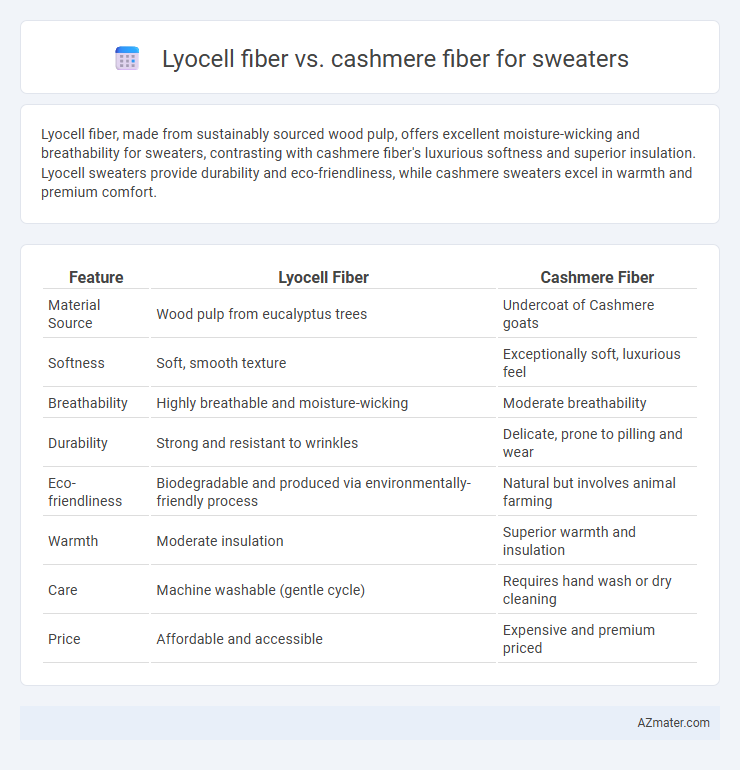Lyocell fiber, made from sustainably sourced wood pulp, offers excellent moisture-wicking and breathability for sweaters, contrasting with cashmere fiber's luxurious softness and superior insulation. Lyocell sweaters provide durability and eco-friendliness, while cashmere sweaters excel in warmth and premium comfort.
Table of Comparison
| Feature | Lyocell Fiber | Cashmere Fiber |
|---|---|---|
| Material Source | Wood pulp from eucalyptus trees | Undercoat of Cashmere goats |
| Softness | Soft, smooth texture | Exceptionally soft, luxurious feel |
| Breathability | Highly breathable and moisture-wicking | Moderate breathability |
| Durability | Strong and resistant to wrinkles | Delicate, prone to pilling and wear |
| Eco-friendliness | Biodegradable and produced via environmentally-friendly process | Natural but involves animal farming |
| Warmth | Moderate insulation | Superior warmth and insulation |
| Care | Machine washable (gentle cycle) | Requires hand wash or dry cleaning |
| Price | Affordable and accessible | Expensive and premium priced |
Introduction to Lyocell and Cashmere Fibers
Lyocell fiber is a sustainable, biodegradable fabric made from wood pulp, known for its softness, breathability, and moisture-wicking properties, making it an excellent choice for sweaters. Cashmere fiber, derived from the undercoat of cashmere goats, offers exceptional warmth, lightweight softness, and luxury feel, prized in high-end sweater production. Both fibers provide distinct benefits, with lyocell emphasizing eco-friendliness and moisture management, while cashmere highlights premium softness and insulation.
Origins and Production Processes
Lyocell fiber, derived from sustainably sourced wood pulp, undergoes a closed-loop production process minimizing environmental impact through solvent recovery and reuse. Cashmere fiber originates from the undercoat of Cashmere goats, primarily found in Mongolia and China, requiring delicate hand-combing during the molting season to obtain fine, soft fibers. The Lyocell production emphasizes eco-friendly practices, while Cashmere relies heavily on traditional artisanal techniques for harvesting and processing.
Environmental Impact Comparison
Lyocell fiber is produced from sustainably sourced wood pulp using a closed-loop process that recycles water and solvents, resulting in minimal environmental pollution and lower carbon emissions compared to traditional fibers. Cashmere fiber, derived from the undercoat of cashmere goats, poses significant environmental challenges due to overgrazing, land degradation, and high water consumption in goat farming areas. Sweaters made from Lyocell typically have a smaller ecological footprint, offering a more sustainable alternative to cashmere in terms of resource use and environmental impact.
Texture and Comfort Differences
Lyocell fiber offers a smooth, silky texture with excellent breathability and moisture-wicking properties, making it ideal for lightweight, comfortable sweaters. Cashmere fiber provides a luxurious, soft, and exceptionally warm feel due to its fine wool fibers, perfect for cozy, insulating garments in cold weather. While Lyocell excels in cool, breathable comfort, cashmere delivers unparalleled softness and thermal insulation for plush sweater experiences.
Durability and Longevity
Lyocell fiber offers excellent durability and maintains its shape well under repeated wear and washing, making it a long-lasting option for sweaters. Cashmere fiber, prized for its softness and warmth, requires delicate care to prevent pilling and fiber breakage, which can reduce its longevity. Sweaters made from Lyocell typically resist abrasion better and retain structural integrity longer compared to the more delicate and moisture-sensitive cashmere.
Warmth and Insulation Properties
Lyocell fiber offers moderate warmth with excellent breathability and moisture-wicking properties, making it suitable for lightweight sweaters in mild climates. Cashmere fiber provides superior insulation and exceptional warmth due to its fine, natural crimp, making it ideal for cold-weather sweaters. While Lyocell excels in comfort and temperature regulation, cashmere's natural fiber density and softness deliver unmatched thermal insulation.
Moisture Absorption and Breathability
Lyocell fiber exhibits excellent moisture absorption, capable of absorbing up to 50% of its weight in water while maintaining breathability, which helps regulate body temperature and wick sweat away from the skin. Cashmere fiber, derived from the undercoat of cashmere goats, offers moderate breathability and moisture absorption but tends to retain moisture longer, potentially causing discomfort in humid conditions. For sweaters, Lyocell provides superior moisture management and ventilation, making it ideal for active wear, whereas Cashmere excels in warmth and softness but may require more careful moisture control.
Hypoallergenic and Skin Sensitivity Factors
Lyocell fiber is highly hypoallergenic, making it an excellent choice for sensitive skin due to its smooth, moisture-wicking properties that reduce irritation and bacterial growth. Cashmere fiber, while luxurious and soft, may cause allergic reactions in some individuals because of lanolin and its natural animal protein content. For those with skin sensitivities, Lyocell provides a more breathable and gentle fabric option that minimizes risks of dermatitis or allergic responses in sweaters.
Care and Maintenance Requirements
Lyocell fiber used in sweaters requires gentle machine washing or hand washing with mild detergent and air drying to maintain its softness and durability, while avoiding high heat to prevent shrinkage and damage. Cashmere fiber demands even more delicate care, including hand washing with cold water or dry cleaning, and laying flat to dry to prevent stretching and pilling, as well as storing properly to avoid moth damage. Both fibers benefit from gentle handling, but cashmere's luxury nature necessitates stricter maintenance to preserve its fine texture and longevity.
Cost and Value Considerations
Lyocell fiber offers a cost-effective alternative for sweaters, providing durability, moisture-wicking, and eco-friendly benefits that enhance overall value without a high price tag. Cashmere fiber, known for its premium softness and thermal insulation, commands a significantly higher cost due to its scarcity and labor-intensive processing. Choosing between Lyocell and cashmere sweaters depends on budget constraints and desired luxury versus sustainability performance attributes.

Infographic: Lyocell fiber vs Cashmere fiber for Sweater
 azmater.com
azmater.com